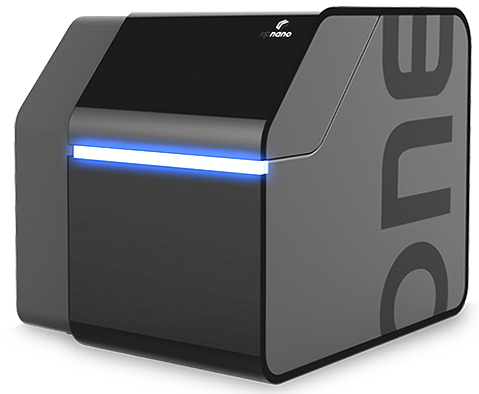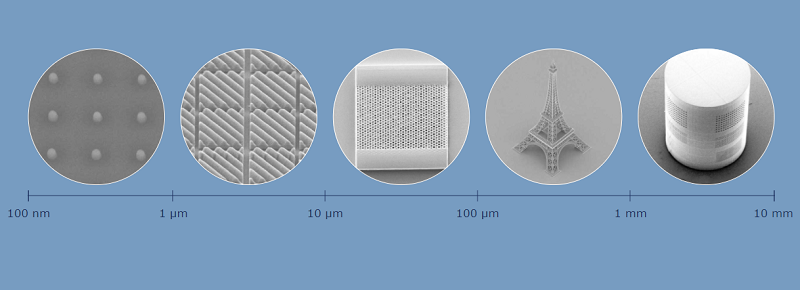Vienna, Austria-based company UpNano, which is commercializing an ultrafast, nano and microscale 3D printing system called the NanoOne, has added even more laser power to its solution. Combine that with “smart” algorithms for laser scanning, an optimized optical pathway, and patented adaptive resolution technology, and UpNano is now able to achieve faster, more precise 3D printing at an even higher resolution than before.
The NanoOne is based on multiphoton lithography, and uses a technique called two-photon polymerization (2PP or TPP, depending on who you ask) that can achieve extremely precise 3D prints at submicron resolution.
“Parts with nano- and microscale resolution can now be printed across 12 orders of magnitude—within times never achieved previously,” UpNano explained in a statement. “This has been accomplished by UpNano, a spin-out of the TU Wien, which developed a high-end two-photon polymerization (2PP) 3-D-printing system that can produce polymeric parts with a volume ranging from 100 to 1012 cubic micrometers. At the same time the printer allows for a nano- and microscale resolution.”
UpNano says that 2PP 3D printing was only able to be “optimized for a very limited range of scale,” which wasn’t very helpful in terms of industry and R&D applications, and the length of time it took to fabricate parts in the centimeter range, or meso-scale, was too long to make it an option for quantitative industry production. But they say that the NanoOne is changing all this, claiming that, in just minutes, the system is able to print extremely precise parts with nano and micrometer resolution, ranging in size from centi-, milli-, and micrometers.
Peter Gruber, the head of technology and co-founder of UpNano, said, “We developed and patented an innovative adaptive resolution technology for our 3-D printing system. Together with an optimized optical path and smart algorithms, we can utilize the full laser power up to 1 Watt, which is several times more than in comparable systems.”
The company isn’t just all talk and no action, either: they recently demonstrated the power of the NanoOne by 3D printing four tiny Eiffel Tower models in a range of sizes, from 200 micrometers to four centimeters, within 30 minutes to nine hours.
“The benefit of this innovation is most notable in the meso-range,” stated UpNano’s CEO Bernhard Küenburg. “The NanoOne system offers significant faster production times than other systems. Add our patented adaptive resolution technology to this and you end up with a capability to print centimeter large objects with a micrometer resolution in short production cycles.”
When you use a printer with a weaker laser, throughput is more restricted. In the NanoOne’s proprietary adaptive resolution mode, the printer’s powerful laser packs enough of a punch to achieve high-speed 3D printing. This increased speed is helped by its specific optical pathways, as well as its smart laser scanning algorithms, making it possible to make the laser spot wider up to a factor of ten, with, UpNano noted, “the specifications of the printed specimen.” Additionally, by changing objectives, which vary from 4x to 100x magnification, parts in the micro-range can be rapidly printed with nanometer scale resolution.
Because the ultra-high resolution NanoOne is so versatile, it’s got plenty of people from different applications interested. For instance, it could be put to good use in the medical field by 3D printing microneedles, which require defined features, like the cannula or reservoir, and tight tolerances. Another possible application for UpNano’s technology is functional micro-mechanic parts, such as a functional, 6 mm spring the company printed in less than six minutes, or two-component parts, printed in just one job, that include moveable elements.
A final example of an application for the size and ranges that the NanoOne system is capable of rapidly printing are filters.
Küenburg stated, “Such filters have exactly defined pore sizes for 100 percent of all pores.”
Measured at several square centimers, these filters have pores sized in the lower single digits of the micrometer-range…vitally important for quality filter and separation results.
(Source: Phys.org / Images: UpNano)
Subscribe to Our Email Newsletter
Stay up-to-date on all the latest news from the 3D printing industry and receive information and offers from third party vendors.
You May Also Like
3D Printing Unpeeled: $5000 Cold Spray 3D Printer, Roland DGA & Living Materials
The AeroForge is a $5000 cold spray metal printer for copper made by a student team at Rice University. In a paper for ACS Central Science a team from Nanjing...
3D Printing Webinar and Event Roundup: April 28, 2024
In this week’s 3D Printing Webinar and Event Roundup, the Ceramics Expo is taking place in Michigan, Stratasys continues its advanced training courses, and SPE is holding a Polymer Characterization...
Meltio Expands Global Reach with New Partnerships in the Americas and Europe
Spanish 3D printing manufacturer Meltio has expanded its sales network across the globe. With the addition of three new partners in the United States, Brazil, Argentina, and Italy, Meltio aims...
US Army Corps of Engineers Taps Lincoln Electric & Eaton for Largest 3D Printed US Civil Works Part
The Soo Locks sit on the US-Canadian border, enabling maritime travel between Lake Superior and Lake Huron, from which ships can reach the rest of the Great Lakes. Crafts carrying...


































